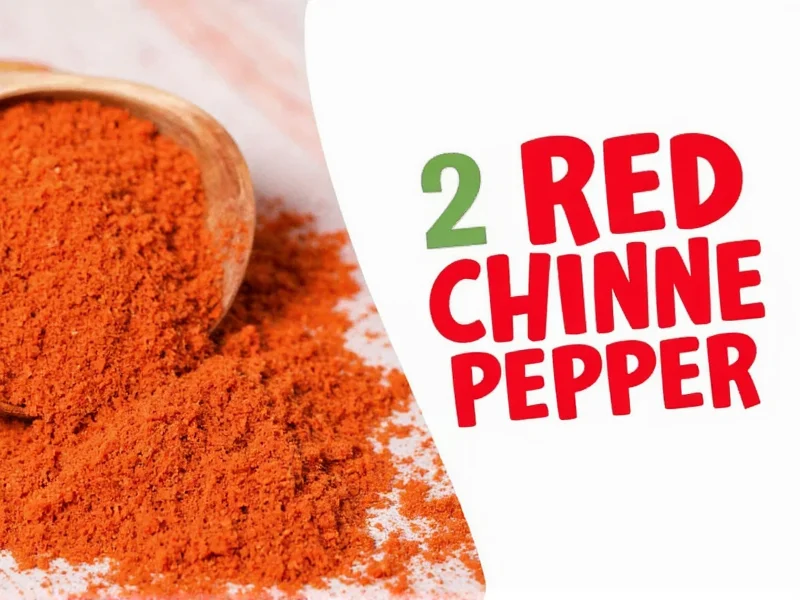Understanding the difference between cayenne pepper and red pepper requires clarifying terminology confusion that often trips up home cooks. Many people mistakenly use these terms interchangeably, but they represent distinct culinary ingredients with unique properties. This comprehensive guide will eliminate confusion and help you use each correctly in your cooking.
What Exactly Is Cayenne Pepper?
Cayenne pepper comes from specific cultivars of Capsicum annuum that originated in French Guiana but are now grown worldwide. Named after the city of Cayenne in French Guiana, this slender, tapered chili typically measures 2-5 inches long and ripens to a bright red color. When dried and ground, it becomes the familiar cayenne powder found in spice racks.
The defining characteristic of cayenne is its significant heat. On the Scoville scale, cayenne registers between 30,000 and 50,000 heat units, placing it firmly in the “hot” category. Its flavor profile includes earthy, slightly fruity notes beneath the heat, making it more complex than many assume. Professional chefs value cayenne for its consistent heat level and clean pepper flavor without the smokiness found in some other chilies.
Decoding the “Red Pepper” Confusion
The term “red pepper” creates significant confusion because it refers to multiple distinct ingredients:
- Red bell peppers – The sweet, mild members of the Capsicum annuum family that have ripened from green to red
- Crushed red pepper flakes – A common spice blend typically made from various dried red chilies including cayenne, but often mixed with milder peppers
- Paprika – Ground peppers that can range from sweet and mild to hot, depending on the variety used
When recipes call for “red pepper,” they most commonly mean crushed red pepper flakes – not pure cayenne. This is the critical distinction home cooks need to understand. The difference between cayenne pepper and red pepper flakes matters significantly in recipe outcomes.
| Characteristic | Cayenne Pepper | Crushed Red Pepper Flakes |
|---|---|---|
| Primary Composition | 100% ground cayenne chili | Mixture of dried chilies (often cayenne plus others) |
| Heat Level (Scoville) | 30,000-50,000 | 500-2,500 (varies by blend) |
| Flavor Profile | Sharp, clean heat with earthy notes | Complex blend with varying heat levels |
| Texture | Fine, uniform powder | Flaky, irregular pieces |
| Common Culinary Uses | Curries, hot sauces, spice blends | Pizza, pasta, Mediterranean dishes |
Practical Cooking Implications
Understanding the cayenne vs red pepper heat level difference prevents recipe disasters. Substituting one for the other without adjustment can make dishes unpleasantly hot or disappointingly mild. When a recipe calls for crushed red pepper but you only have cayenne, use approximately 1/4 to 1/2 teaspoon of cayenne for every teaspoon of red pepper flakes.
Chefs note that cayenne provides immediate, direct heat that permeates dishes evenly, while crushed red pepper flakes offer more nuanced heat distribution with varying intensity from flake to flake. This makes cayenne better for sauces where consistent heat matters, while red pepper flakes work well as finishing spices where texture and variable heat are desirable.
Nutritional Comparison
Both ingredients share capsaicin (the compound responsible for heat), but in different concentrations. Cayenne contains significantly more capsaicin, which means it delivers more potential metabolic benefits but also greater gastrointestinal risk for sensitive individuals. A single teaspoon of cayenne provides about 44% of your daily vitamin A needs, while red pepper flakes offer approximately 15%.
The difference between cayenne pepper and paprika is particularly important for health-conscious cooks. While both are red powders, paprika ranges from sweet (0 Scoville units) to hot (10,000 units), making it nutritionally distinct from cayenne's consistent high heat. Hungarian paprika, for example, contains different carotenoids that provide unique antioxidant profiles compared to cayenne.
Storage and Shelf Life
Both spices lose potency over time but at different rates. Ground cayenne maintains its heat intensity longer than crushed red pepper flakes due to its finer particle size and lack of mixed components. Store both in airtight containers away from light and heat. Properly stored, cayenne retains optimal potency for 2-3 years, while red pepper flakes typically peak at 1-2 years before flavor degradation becomes noticeable.
Common Misconceptions Clarified
Many believe “crushed red pepper” and “cayenne” are identical. In reality, most commercial crushed red pepper contains cayenne plus other milder chilies like bell peppers or ancho peppers. The is cayenne pepper the same as red pepper question has a definitive answer: no, though they’re related.
Another frequent error involves substituting smoked paprika for cayenne. While both are red powders, smoked paprika introduces a completely different flavor dimension that doesn’t replicate cayenne’s clean heat. Understanding these distinctions represents the practical application of knowing the difference between cayenne pepper and red pepper in real cooking scenarios.
When Substitutions Make Sense
While not identical, strategic substitutions work in certain contexts. For dishes requiring moderate heat with texture (like pizza or focaccia), crushed red pepper makes an excellent substitute for cayenne when used at 3-4 times the quantity. Conversely, when a recipe needs intense, uniform heat (like cayenne-spiked chocolate or certain curry blends), nothing adequately replaces pure cayenne powder.
The can I substitute cayenne for red pepper question depends entirely on your heat tolerance and the dish’s requirements. In egg dishes or mild sauces, use 1/8 teaspoon cayenne per teaspoon of red pepper flakes. For heartier dishes like chili or barbecue rubs, you might use equal amounts if you prefer intense heat.











 浙公网安备
33010002000092号
浙公网安备
33010002000092号 浙B2-20120091-4
浙B2-20120091-4